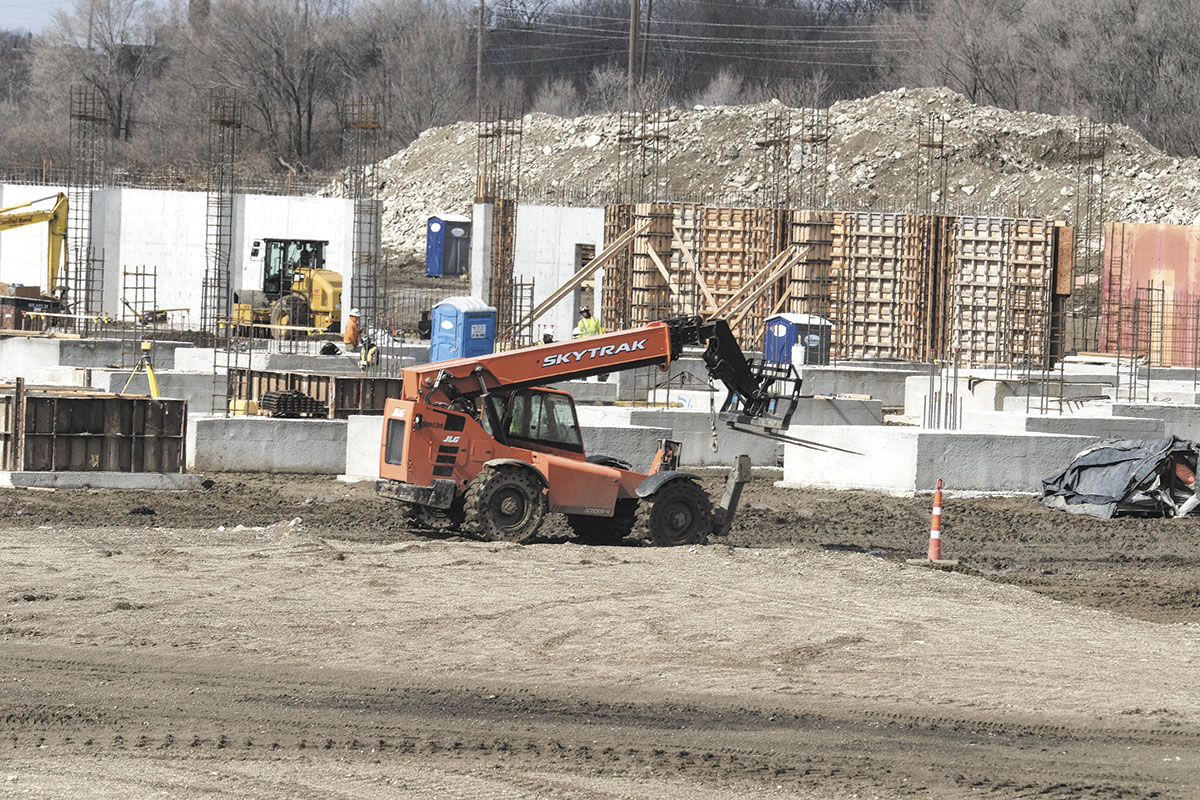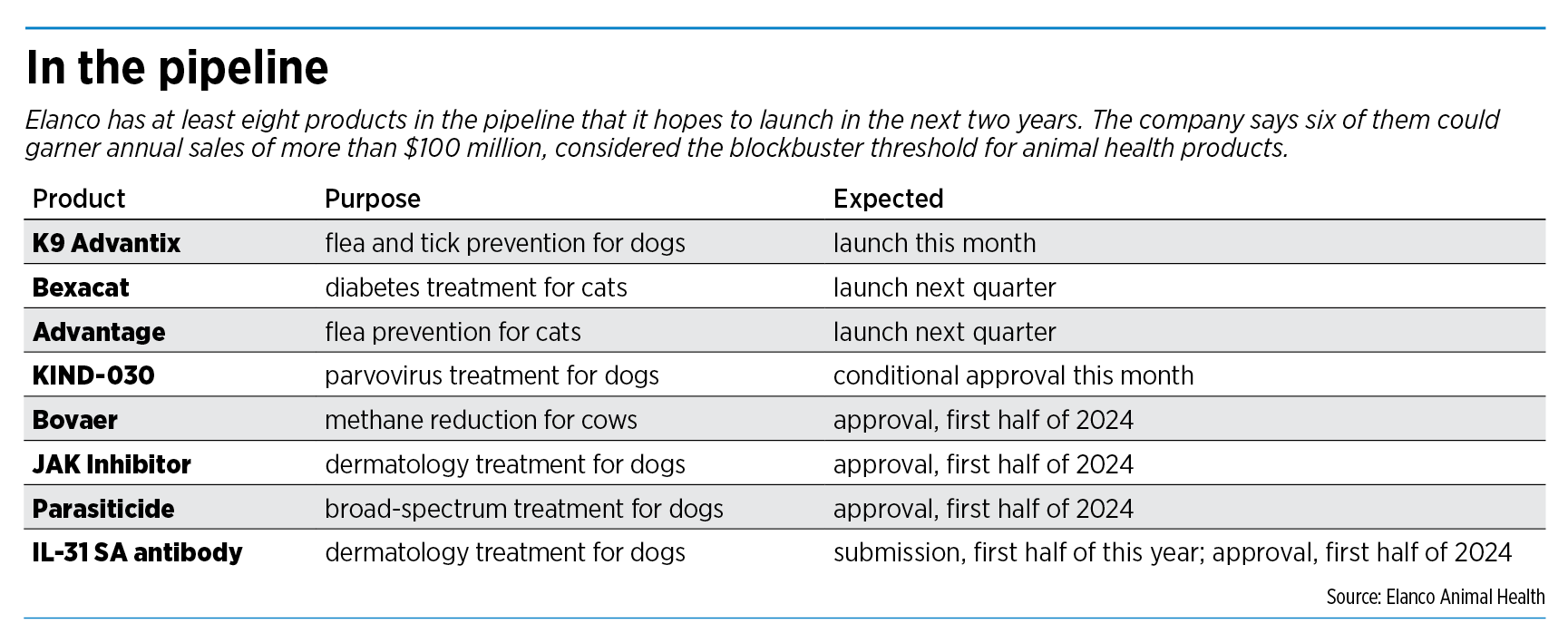Subscriber Benefit
As a subscriber you can listen to articles at work, in the car, or while you work out. Subscribe Now
The new headquarters site of Elanco Animal Health Inc. is buzzing with activity, with cranes towering over the 44-acre footprint and concrete footers rising from the ground.
If all goes to schedule, the $150 million project will wrap up late next year, completing what could be an amazing transformation of the defunct General Motors stamping plant property on the west side of downtown, across from the White River, that sat vacant for more than a decade.

But not everything at Elanco is quite as upbeat. Shares in the company have lost more than two-thirds of their value in the past 18 months. Revenue last year fell 7%, and CEO Jeff Simmons recently said he expects revenue to be flat to down 3% this year.
The Greenfield-based company—which makes animal vaccines, antibiotics and other health products for pets and farm animals—has lost money three straight years, totaling more than $1.1 billion.
But the losses are narrowing, dropping from $560 million in 2020 to $78 million in 2022, and Elanco boasts that a bevy of new products in its pipeline will prove an era of strong growth is yet to come.
Still, the company is weighed down by more than $5 billion in debt, much of it taken on when it bought the animal health unit of German pharmaceutical giant Bayer AG in 2020 for $6.9 billion. The acquisition instantly catapulted Elanco from fourth place to second place in the $33 billion animal-health industry but left it with a massive job of integrating two global companies.
Shares in the company have fallen nearly 69% from their high in the $36 range in the summer of 2021, even as the broader Nasdaq market has fallen only 22% during that time. Elanco’s largest competitor, New Jersey-based Zoetis Inc., saw its shares rise 11% during the period.
In recent months, analysts have lowered their projections on Elanco. Today, eight of 12 analysts who follow Elanco have a hold recommendation, three have a buy recommendation and one has a sell recommendation, according to CNN Business.
“We see better opportunities elsewhere within our animal-health coverage over the next 12 months,” JP Morgan analyst Chris Schott told investors in a report last summer, when he downgraded his rating from buy to hold. He has since cut his price projections on Elanco stock several times as shares have continued to fall.
But Simmons is pushing back, saying the company has a promising pipeline of products that it expects to launch over the next two years.
He said Elanco has the right strategy and the right leadership and will find its footing again as the economy improves and the company delivers new products into the market. He said he expects investors will come back when the company proves itself.
“We are a stay-the-course, show-me story, as we always have been,” Simmons told IBJ. “No question, this next era of innovation and growth is in front of us.”
Some analysts agree. Cowen’s Steve Scala issued a medium-buy “outperform” rating for Elanco in November, writing that the company’s pipeline is “expected to deliver five blockbuster launches by 2024.”
Others have adopted a wait-and-see approach.

“Management appears to have made some compelling advancements ‘under the hood’ in retooling its R&D organization,” William Blair analyst Andrew Brackmann wrote to clients last summer. “But until new products can prove that the offerings are indeed differentiated and can ramp up quickly, it is difficult to fully expect a reacceleration in growth.”
Elanco’s falling stock price—which was about $11 this week—indicates that many investors are not sold on the company’s growth plans.
“What that suggests is that analysts don’t buy the story,” said David Farber, associate professor of accounting at the Kelley School of Business at IUPUI. “They don’t buy the growth story, and they don’t see the future profitability.”
Challenges ahead
The next few years could be the biggest test yet for Simmons, who has been with Elanco more than two decades and has run it for 14 years—most of that time when it was a division of Indianapolis-based drugmaker Eli Lilly and Co.
Lilly founded Elanco in 1954 as an agricultural and industrial sales division and shifted its focus to animal health—mostly livestock—in the 1980s. It broadened the unit in 2007 to include products for companion animals.
Lilly spun off Elanco as an independent company in 2018, saying it could unlock more value for shareholders.
“We believe this will allow Elanco to efficiently deploy its resources to those growth opportunities that best serve its customers,” Lilly CEO David Ricks said at the time.
Elanco went public at $24 a share in September 2018, and at first, investors seemed on board with management’s story that Elanco was a growth company with a bright future. On the first day of trading as an independent company, shares closed up 50%.
Yet the future turned out to be decidedly mixed. The stock has bounced up and down and is now trading at about half of its IPO price.
Today, investors value Elanco at $5.4 billion as a company, down sharply from $13.4 billion in January 2022.
Two weeks ago, company shares fell 12% in one day after Elanco announced that fourth-quarter revenue fell due to environmental and competitive pressure and could continue to slip this year. The company lost $54 million in the quarter and $74 million for the full year.
On an adjusted basis, Elanco posted earnings of $174 million in the fourth quarter and $1.02 billion for the full year.
Simmons is continuing to sell the message that the company’s future is bright.
In recent months, he has traveled to conferences hosted by Morgan Stanley, Bank of America, JP Morgan, Evercore ISI and other investment banks, where analysts and fund managers meet to hear which companies have the most promising stories.
In an interview this week with IBJ, Simmons said Elanco has much more growing to do.
“We’ve grown this company from under a billion dollars [a year], when I took it over, to where we are now: $4.5 billion,” Simmons said. “And we’ve got the right strategy.”
He pointed out that the company met expectations for six consecutive quarters from the time it completed the Bayer acquisition in August 2020 through the first quarter of 2022. It also expanded its adjusted earnings margins throughout that period.
In the past nine months or so, however, the company has run into numerous setbacks, from COVID lockdowns in China and a supply-chain disruption to a global economic slowdown and historic inflation.
All those factors, plus Elanco’s slowness in commercializing new products, turned off some analysts.
“The ramp of new product revenue has been more prolonged than anticipated, macro and competitive pressures have increased, and cost headwinds have emerged as an offset to margin expansion,” Goldman Sachs analyst Nathan Rich wrote to clients last July, when he downgraded his rating on Elanco stock from buy to sell.
Simmons acknowledged that Elanco revenue will likely continue to decline in the first half of this year but said he expects new products and better economic conditions to help the company boost revenue as it begins to launch a series of products over the next two years, from flea and tick prevention for dogs to methane reduction for cows.
He predicted the company will introduce six products that will garner annual sales of at least $100 million each. In the world of animal health, those products would be considered blockbusters.
“We have a path to six blockbusters,” he said. “Never have I seen that in the history of Elanco, or animal health.”
“That will change the trajectory” of Elanco, he added.

Making moves
Last month, Elanco announced it had hired an industry veteran, Tim Bettington, as its executive vice president of corporate strategy and market development. Bettington’s mission is to focus on “launch readiness” and prepare Elanco for a “historic innovation window,” the announcement said.
Bettington, who has worked in the animal health industry for 25 years, most recently served as executive vice president at Zoetis Inc., the largest player, where he was responsible for U.S. operations and global customer experience.
“As I considered the next step in my journey, Elanco was the obvious choice,” Bettington said in the announcement. “I believe they are also now the company with the greatest potential for long-term value creation.”
Elanco, meanwhile, is chipping away at its huge debt, taking it from $6.4 billion at the end of 2021 to $5.8 billion at the end of 2022.
Even so, that level of debt for a company with flat revenue could cause huge difficulties, some financial experts say.
“They have that debt burden that they need to satisfy,” said Farber of IUPUI’s Kelley School. “If they can’t grow their top line, they’re in big trouble. That’s holding them back.”
Simmons said the company plans to drive down debt at a more rapid pace in the next few years. “Debt paydown is our number one capital priority,” he said.
One way to do that, he said, is through the savings the company has made by buying Bayer Animal Health. Next month—nearly three years after Elanco closed its acquisition of Bayer Animal Health—the two companies will migrate their information technology to one system.
Simmons said that move alone will free a huge sum of money to pay down debt and to invest in launches and other functions.
Mixed response
Wall Street’s reaction to that message has been mixed.
As far back as October 2020, activist hedge fund Sachem Head Capital Management, based in New York, announced it owned a $1.2 billion stake in Elanco. It said it planned to push for changes at the company. The fund said Elanco’s stock, then trading in the low-$30 range, was “undervalued” and an “attractive investment.”
Two months later, the hedge fund’s managing partner, Scott Ferguson, got a seat on Elanco’s board. He kept it until last September, when Elanco suddenly announced that he was resigning to spend additional time on “other opportunities in Sachem Head’s portfolio” and on two other public-company boards.
“I have enjoyed working with my fellow directors since my appointment in December 2020, and I believe that the Company has established the right plan to create shareholder value through sustained cost discipline and developing its innovation pipeline,” Ferguson said in written remarks, according to Elanco’s press release. “As the Company executes on its plan, I believe the market will come to appreciate the good work that is being done by management and the board.”
The company did not say what changes it made, if any, in strategy or management, to accommodate Ferguson. Three months ago, Sachem disclosed it had sold about two-thirds of its holdings in Elanco but did not say if it lost or made money on its investment.
However, Simmons said Elanco’s five largest shareholders actually increased their investment in the fourth quarter. The company’s largest investors include Dodge & Cox, Vanguard Group, Primecap Management and Blackrock.
Meanwhile, over at the old GM stamping plant, work continues on the company’s new headquarters, which will be centered by a six-story, glass office building, along with a laboratory and support buildings.
Simmons predicted that the project will become an “epicenter of animal health” and said he hopes the campus attracts startups and support companies in the industry.
Even if Elanco takes a while to regain its balance, the headquarters project is moving ahead.
The company said it expects its investment will be offset by “competitive incentive packages” offered by the state and city. As IBJ earlier reported, an incentive package totaling at least $150 million is possibly the largest amount of combined state and local tax breaks ever considered.
Simmons said he is excited about a headquarters project that “will be a destination” for employees.
“We’ve got a global team that is executing with excellence,” he said. “We’re excited about building a headquarters and locating it here and setting up an epicenter to bring innovation here that can reach the world’s animals.”•
Please enable JavaScript to view this content.



Only 1 of 16 analysts say “sell” while most say “hold.” Seems like a good time to “buy.”
Exactly. Not only that there’s so many dooms-day analysist right now it makes me sick. Everyone fears the unknown. It doesn’t mean jack. The company has big goals and promising new products. If you believed in Lilly (everyone at this point) buying more Elanco shares is good idea.